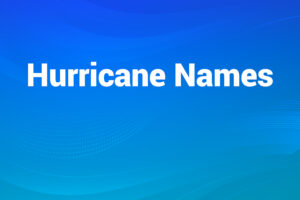When tracking a powerful storm you may wonder why it has a name like Katrina or Ida. The way those names are chosen involves science, history, and a global agreement.
In the United States you need to understand how names help you stay safe, how lists are reused every six years, why some names are retired, and how this practice affects public communication.
In this article you will learn how hurricane names are selected, why they change, what rules apply, and how they evolve with climate and communication challenges.
What is a Hurricane Name?
A hurricane name is a label assigned to a tropical cyclone once it reaches a certain intensity so that forecasters, media and the public can refer to it clearly instead of using numbers or latitude‐longitude. In the Atlantic basin the threshold for naming is when sustained winds reach 39 mph (tropical storm strength). From that point it retains that name through its lifecycle.
Why Assign Names at All?
In the early days storms were tracked only by numbers or coordinates. That made communication clumsy. Naming storms makes it simpler for you and officials to follow track, issue warnings, and recall events. A short and distinct name reduces confusion, especially when multiple storms occur in the same region at once.
How Did the Practice Start?
The idea of naming weather systems dates back to the late 19th century when a meteorologist named systems in Queensland, Australia. Over time military practices during World War II used alphabetic code names. In the U.S., the formal system of naming Atlantic storms began in 1950 and in 1953 the switch to female names occurred. Since 1979 male names were included, so the lists alternate gender. The practice has grown into a formal system maintained by the World Meteorological Organization (WMO).
How Are Names Picked?
In the Atlantic basin you’ll find six lists of 21 names each (skipping Q, U, X, Y and Z). These lists rotate every six years. For example the list used in 2024 will be used again in 2030. If more storms occur than names available, a supplemental list is used. Names must be short, easy to pronounce, culturally acceptable and not duplicated in a recent season.
Regional Differences in Naming
Naming systems differ around the world. In the Eastern and Central Pacific Oceans there are separate lists with similar rotation rules. In the Western Pacific, North Indian Ocean and Southern Hemisphere basins names may include objects, trees, animals or local words instead of personal first names. Each meteorological region coordinates naming via its own centre under WMO oversight.
Retiring Names and Why That Matters
When a storm becomes particularly deadly or costly its name is retired rather than reused. That helps avoid confusion or insensitivity to the communities affected. For instance names such as Katrina and Irma were retired after causing massive damage. The replacement name then enters the rotation. As of 2025 many names are retired and no longer appear in future season lists.
What Happens When More Names Than Planned Are Needed?
Typically the 21‑name list covers most seasons. But in exceptionally active years more storms form than there are names. Prior to 2021 the Greek alphabet (Alpha, Beta, Gamma…) was used in the Atlantic to continue naming. Since then a supplemental list has replaced the Greek alphabet for clarity and to avoid confusion.
Benefits of the Naming System for You
For you as a resident or viewer the naming system:
- Helps you recognise and remember the storm being discussed in media or alerts
- Avoids confusion when multiple storms develop at once
- Allows emergency managers to refer to specific storms by name clearly
- Enhances tracking and historical records of storm events
Criticisms and Challenges
Some critics argue that names may cause people to underestimate the threat based on gender or familiarity. Research has suggested public response can vary depending on the perceived severity associated with a name. Others note that as climate change increases storm frequency and intensity, naming systems may face pressure to adapt further.
How the Lists are Updated
Each year the relevant hurricane committee (under WMO) meets and reviews if any names should be retired. Then replacements are selected for upcoming rotation lists. Names are chosen with attention to cultural diversity, pronunciation across languages, and avoidance of names of recent severe storms or public figures.
What You Can Do Ahead of Hurricane Season
- Familiarise yourself with the current year’s list of names in your region so you recognise names being used
- Monitor storms by name instead of just “storm 1” or “tropical system” to help you follow updates
- Understand that a named storm is serious—track its strength, path and official warnings
- Note when names are retired — past names signal major impact events in your region’s history
What the Future Holds
As storms grow more frequent and intense, naming conventions may evolve. The WMO may need to expand supplemental lists, adjust language rules or improve public education around what a name actually implies. The aim remains clear communication, public safety and historical accuracy.
Choosing Your Region’s Names
In your region (Atlantic basin) you will see names announced before the season starts (June 1 for Atlantic). Local meteorological agencies publish the list ahead of time so you can be ready. For example, the list for the 2025 Atlantic season was released with alerts that the season could be above average. Communicating using those names starts long before any storm makes landfall.
Common Myths About Hurricane Names
- Storm names are not chosen by popular vote. They come from predetermined lists
- A weaker storm with a name not being upgraded doesn’t mean it is safe. Names are assigned at tropical storm strength
- A name doesn not imply sex or severity—severity depends on storm strength and path
- A retired name is not due to superstition, it reflects major impact
- Naming does not guarantee safety—one must still follow official bulletins
Conclusion
The process of naming hurricanes simplifies communication, helps you follow weather alerts, and ensures clarity when multiple storms occur. You benefit when agencies use names that are clear, recognised and consistent. As you ready yourself for each hurricane season, knowing how names are chosen, why some names retire and how your region handles naming gives you an edge in preparedness. Staying aware of the naming convention is part of responsible storm season readiness.
FAQ’s
What determines when a storm receives a name?
A storm receives a name when it reaches tropical storm strength, typically defined as sustained winds of 39 mph or higher, in the region where the naming centre applies.
How often are the hurricane name lists reused?
In the Atlantic basin the six lists rotate every six years, meaning the 2024 list appears again in 2030, unless names have been retired and replaced.
Can the same hurricane name be used again?
Yes, names can be reused unless they have been retired following a storm that caused significant damage or loss of life. Retired names do not return to the list.
Why skip certain letters in the naming lists?
Letters like Q, U, X, Y and Z are skipped because names beginning with those letters are harder to pronounce, less familiar across languages, and might confuse.
What happens if there are more storms than names available?
If names on the primary list are exhausted in a season, a supplemental list is used to continue naming new storms. Earlier the Greek alphabet was used in the Atlantic as backup.
Do other parts of the world follow the same naming rules as the U.S.?
Other basins follow similar principles—predetermined lists, regional committees under the World Meteorological Organization—but they may include non‑personal names (like flowers or animals) or different criteria for naming.
Why might a particular hurricane name be retired?
A name is retired when a storm with that name caused a large number of deaths, major damage or significant disruption. This prevents reuse and respect the memory of the impact.










